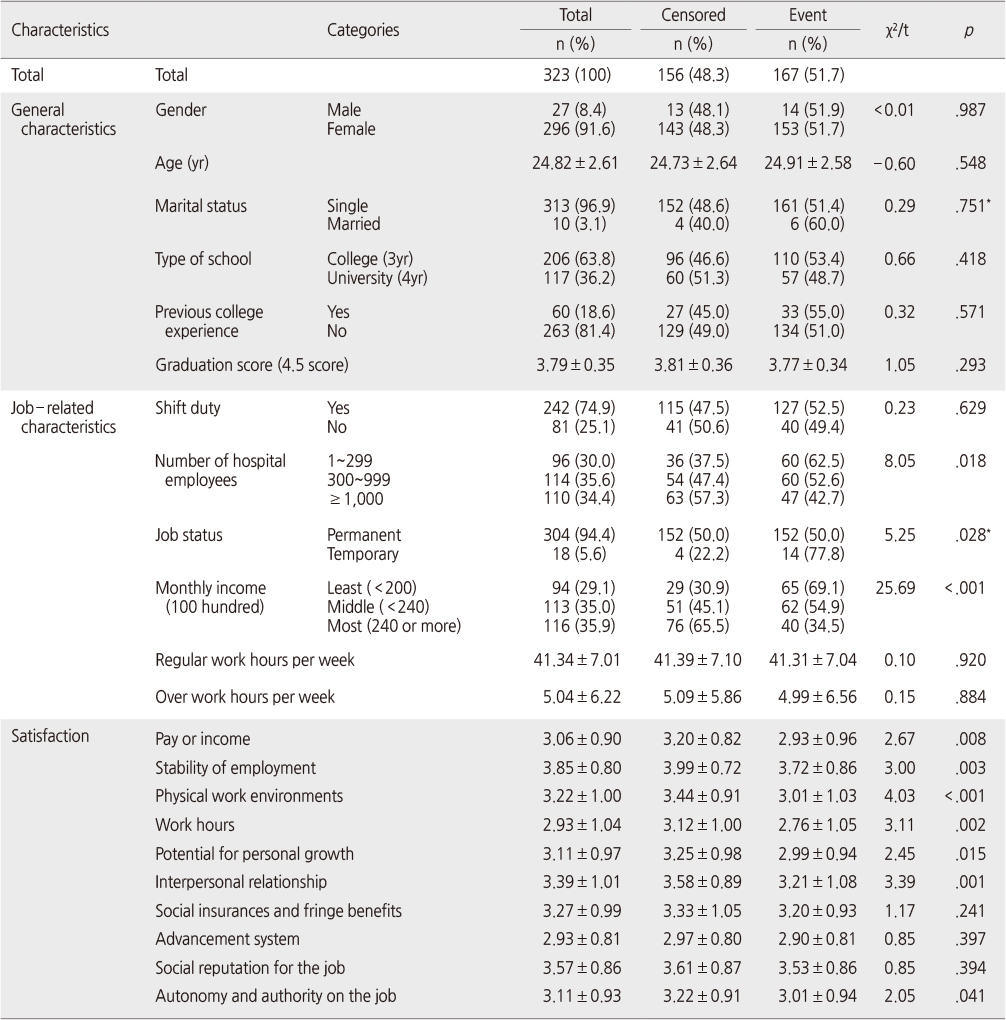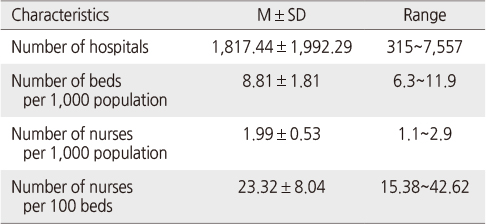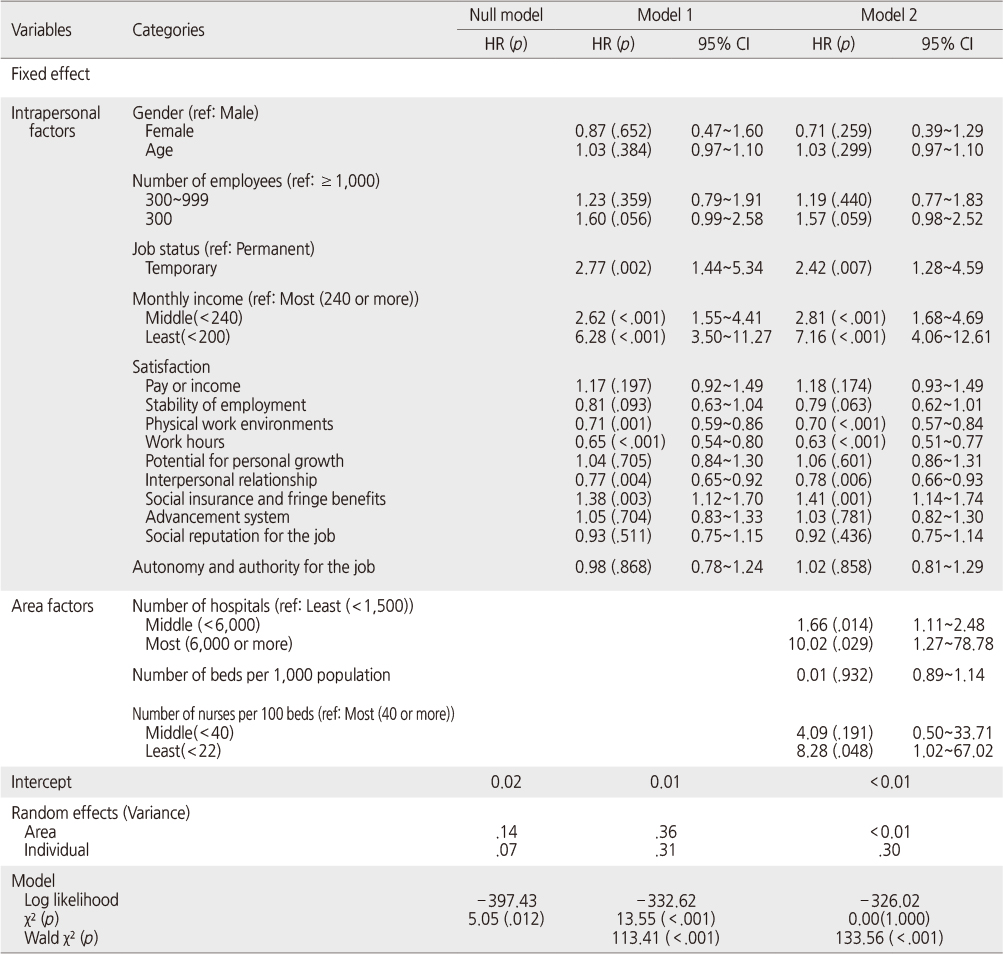Articles
- Page Path
- HOME > J Korean Acad Nurs > Volume 46(5); 2016 > Article
-
Original Article
- Predictors of Turnover among New Nurses using Multilevel Survival Analysis
- Suhee Kim, Kyongeun Lee
-
Journal of Korean Academy of Nursing 2016;46(5):733-743.
DOI: https://doi.org/10.4040/jkan.2016.46.5.733
Published online: October 31, 2016
1College of Nursing·Mo-Im Kim Nursing Research Institute, Yonsei University, Seoul, Korea.
2Department of Nursing, Tongmyong University, Busan, Korea.
- Address reprint requests to : Lee, Kyongeun. Department of Nursing, Tongmyong University, 428 Sinseon-ro, Nam-gu, Busan 48520, Korea. Tel: +82-51-629-2686, Fax: +82-51-629-2679, leekyongeun@gmail.com
• Received: November 17, 2015 • Revised: August 5, 2016 • Accepted: August 8, 2016
© 2016 Korean Society of Nursing Science
This is an Open Access article distributed under the terms of the Creative Commons Attribution NoDerivs License. (http://creativecommons.org/licenses/by-nd/4.0/) If the original work is properly cited and retained without any modification or reproduction, it can be used and re-distributed in any format and medium.
Abstract
-
Purpose
- The purpose of this study was to examine factors influencing new graduate nurse turnover.
-
Methods
- This study was carried out as a secondary analysis of data from the 2010 Graduates Occupational Mobility Survey (GOMS). A total of 323 nurses were selected for analysis concerning reasons for turnover. Data were analyzed using descriptive statistics and multilevel survival analysis.
-
Results
- About 24.5% of new nurses left their first job within 1 year of starting their jobs. Significant predictors of turnover among new nurse were job status, monthly income, job satisfaction, the number of hospitals in region, and the number of nurses per 100 beds.
-
Conclusion
- New graduate nurses are vulnerable to turnover. In order to achieve the best health of the nation, policy approaches and further studies regarding reducing new graduate nurse turnover are needed.
- 1. OECD. Health care resources: nursing graduates [Internet]. Seoul, OECD. 2012;cited 2015 May 17. Available from: https://data.oecd.org/healthres/nursing-graduates.htm#indicatorchart
- 2. Yoon HK, Choi J, Lee EY, Lee H, Park M. Effects of decision making competency, nursing professionalism, and job satisfaction on turnover impulse among nurses. J Korean Acad Nurs Adm. 2013;19(5):658–667. Article
- 3. Jeong EJ, Chae GS, Noh WJ, Park MM, Cho UY, Kim HJ. A survey on hospital nursing staffing. Business report for Hospital Nurses Association. Seoul: Hospital Nurses Association; 2013.
- 4. Hayes LJ, O'Brien-Pallas L, Duffield C, Shamian J, Buchan J, Hughes F, et al. Nurse turnover: a literature review–an update. Int J Nurs Stud. 2012;49(7):887–905. ArticlePubMed
- 5. Jones CB. Revisiting nurse turnover costs: Adjusting for inflation. J Nurs Adm. 2008;38(1):11–18. PubMed
- 6. Cho HK, Lee TY, Kim CW. Hospital nurse turnover rate and structural characteristics of hospital. J Korea Acad Ind Coop Soc. 2015;16(1):453–461. Article
- 7. Zeytinoglu IU, Denton M, Davies S, Baumann A, Blythe J, Boos L. Deteriorated external work environment, heavy workload and nurses' job satisfaction and turnover intention. Can Public Policy. 2007;33(1):S31–S47. http://www.jstor.org/stable/30032503Article
- 8. Han SS, Sohn IS, Kim NE. New nurse turnover intention and influencing factors. J Korean Acad Nurs. 2009;39(6):878–887. ArticlePubMed
- 9. Hwang YS, Kang KH. Factors influencing nurse turnover intention in small and medium sized hospitals in the metropolitan area. J Korean Acad Nurs Adm. 2014;20(5):576–586. Article
- 10. Lee YJ, Kim KB. Experiences of nurse turnover. J Korean Acad Nurs. 2008;38(2):248–257.Article
- 11. Kim KM, Yim JY, Kim EJ, Lee YM, Hwang MH, Jang JH, et al. The attitude typology of new nurse to turnover: Q methodological approach. J Hum Subj. 2011;23:163–182.
- 12. Cho SH, Lee JY, Mark BA, Yun SC. Turnover of new graduate nurses in their first job using survival analysis. J Nurs Scholarsh. 2012;44(1):63–70. ArticlePubMed
- 13. Cho SH, Lee JY, Mark BA, Lee HY. Geographical imbalances: migration patterns of new graduate nurses and factors related to working in non-metropolitan hospitals. J Korean Acad Nurs. 2012;42(7):1019–1026. ArticlePubMed
- 14. Cho SH, Lee JY, Mark BA, Jones CB. Geographic mobility of Korean new graduate nurses from their first to subsequent jobs and metropolitan-nonmetropolitan differences in their job satisfaction. Nurs Outlook. 2014;62(1):22–28. ArticlePubMed
- 15. Daouk-Öyry L, Anouze AL, Otaki F, Dumit NY, Osman I. The JOINT model of nurse absenteeism and turnover: a systematic review. Int J Nurs Stud. 2014;51(1):93–110.ArticlePubMed
- 16. Locke EA. The nature and causes of job satisfaction. Chicago: Rand McNally; 1976. p. 1297–1349.
- 17. Park JG, Jang SJ, Lee TY. Public health statistics using SPSS 17.0. Seoul: Gyechuk Munwhasa; 2010. p. 206–207.
- 18. Snijders TAB, Bosker RJ. Multilevel analysis: An introduction to basic and advanced multilevel modeling. London: Sage; 1999. p. 1–2.
- 19. Bickel R. Multilevel analysis for applied research: It's just regression. New York: Guilford Press; 2007.07.
- 20. Kovner CT, Brewer CS, Fatehi F, Jun J. What does nurse turnover rate mean and what is the rate? . Policy Polit Nurs Pract. 2014;15(3-4):64–71. ArticlePubMedPDF
- 21. Suh Y, Lee K. Lived experiences of new graduate nurses. J Korean Acad Nurs Adm. 2013;19(2):227–227. Article
- 22. Han SS, Moon SJ, Yun EK. Empowerment, job satisfaction, and organizational commitment: comparison of permanent and temporary nurses in Korea. Appl Nurs Res. 2009;22(4):e15–e20. ArticlePubMed
- 23. Kim WO, Moon SJ, Han SS. Contingent nurses' burnout and influencing factors. J Korean Acad Nurs. 2010;40(6):882–891. ArticlePubMed
- 24. Kang KN. Factors influencing turnover intention of nurses in small-medium sized hospitals. J Korean Acad Nurs Adm. 2012;18(2):155–165.Article
- 25. Bloom JR, Alexander JA, Nuchols BA. The effect of the social organization of work on the voluntary turnover rate of hospital nurses in the United States. Soc Sci Med. 1992;34(12):1413–1424.ArticlePubMed
- 26. Kim YM, Kang YS. The relationship among career plateau, selfefficacy, job embeddedness and turnover intention of nurses in small and medium sized hospitals. J Korea Acad Ind Coop Soc. 2013;14(10):5078–5090. Article
- 27. Kim Y, Lee JY, Kang H. Impact of nurse, nurses' aid staffing and turnover rate on inpatient health outcomes in long term care hospitals. J Korean Acad Nurs. 2014;44(1):21–30. ArticlePubMed
- 28. Lee T, Kang KH, Ko YK, Cho SH, Kim EY. Issues and challenges of nurse workforce policy: A critical review and implication. J Korean Acad Nurs Adm. 2014;20(1):106–116.Article
- 29. Jang JY. Why is the salary of doctors in Ulsan twice higher than that of doctors in Seoul?[Internet]. The Korea Joongang Daily. cited 2016 July 18. Available from: http://news.joins.com/article/20320460
- 30. Ministry of Health and Welfare. 2016 nursing care integrated services guideline. [Internet]. Seoul, Ministry of Health and Welfare. 2016;cited 2016 July 25. Available from: http://www.nhis.or.kr/bbs7/boards/B0040/18240
REFERENCES
Figure & Data
REFERENCES
Citations
Citations to this article as recorded by 

- Prevalence and Moderating Factors of Turnover Rate and Turnover Intention Among Nurses Worldwide: A Meta-Analysis
Dluha Mafula, Hidayat Arifin, Ruey Chen, Chien-Mei Sung, Chiu-Kuei Lee, Kai-Jo Chiang, Kondwani Joseph Banda, Kuei-Ru Chou
Journal of Nursing Regulation.2025; 15(4): 20. CrossRef - Individual and environmental factors that influence longevity of newcomers to nursing and midwifery: a scoping review
Janie Alison Brown, Tanya Capper, Desley Hegney, Helen Donovan, Moira Williamson, Pauline Calleja, Terena Solomons, Sally Wilson
JBI Evidence Synthesis.2024; 22(5): 753. CrossRef - Assessing the impacts of nurse staffing and work schedules on nurse turnover: A systematic review
Sung‐Heui BAE
International Nursing Review.2024; 71(1): 168. CrossRef - Factors associated with practice readiness among newly qualified nurses in their first two years of practice
Siew Hoon Lim, Shin Yuh Ang, Fazila Aloweni, Kee Chen Elaine Siow, Sabrina Bee Leng Koh, Tracy Carol Ayre
Nurse Education Today.2024; 136: 106143. CrossRef - South Korean Nurse Residency Program for New Graduates: A Posttest Study
Jihye Song, Kyunghee Kim, Yunjung Jang
The Journal of Continuing Education in Nursing.2024; 55(8): 393. CrossRef - Socializing into a Profession with High Early Turnover: Nursing Students’ Expectations for Leader-Member Relationships
Jennifer K. Ptacek, Leah M. Omilion-Hodges
Health Communication.2024; 39(11): 2402. CrossRef - An examination of the career decision-making self-efficacy of final-year nursing students
Edah Anyango, Esther Adama, Janie Brown, Irene Ngune
Nurse Education Today.2024; 138: 106196. CrossRef - Association of Work Schedules With Nurse Turnover: A Cross-Sectional National Study
Sung-Heui Bae
International Journal of Public Health.2023;[Epub] CrossRef - Comprehensive assessment of factors contributing to the actual turnover of newly licensed registered nurses working in acute care hospitals: a systematic review
Sung-Heui Bae
BMC Nursing.2023;[Epub] CrossRef - Turnover intention and retention of newly licensed nurses in their first job: A longitudinal study
Hyoung Eun Chang, Sung‐Hyun Cho
International Nursing Review.2023; 70(3): 338. CrossRef - Factors Influencing RNs' Intention to Stay in Nursing Homes: Multilevel Modeling Approach
Sunyeob Choi, Jiyeon Lee
Journal of Gerontological Nursing.2023; 49(7): 40. CrossRef - Factors associated with difficulty in adapting and intent to leave among new graduate nurses in South Korea
Sun-young Park, Heejung Kim, Chenjuan Ma
Health Care Management Review.2022; 47(2): 168. CrossRef - Why Nurses Are Leaving Veterans Affairs Hospitals?
Dongjin Oh, Keon-Hyung Lee
Armed Forces & Society.2022; 48(4): 760. CrossRef - Re-employment Hospital Types of Early Career Nurses and Changes in Work-Life Balance
Eun-Young Kim, Yun-Kyung Oh
STRESS.2022; 30(3): 163. CrossRef - Factors Influencing Re-Employment of Newly Graduated Nurses: Longitudinal Study
Yun Kyung Oh, Eun-Young Kim
Journal of Korean Academy of Nursing.2021; 51(2): 162. CrossRef - Predictors of actual turnover among nurses working in Korean hospitals: A nationwide longitudinal survey study
Sung‐Heui Bae, Mijung Cho, Oksoo Kim, Yanghee Pang, Chiyoung Cha, Heeja Jung, Sue Kim, Hyunseon Jeong
Journal of Nursing Management.2021; 29(7): 2102. CrossRef - The Effect of Neighborhood Characteristics and Friends' Smoking Status on the Habitual Smoking Onset in Adolescents
You-Jung Choi, Gwang Suk Kim
Journal of Korean Academy of Nursing.2021; 51(1): 54. CrossRef - Nurse turnover: A longitudinal survival analysis of the Korea Nurses' Health Study
Young Taek Kim, Oksoo Kim, Chiyoung Cha, Yanghee Pang, Choa Sung
Journal of Advanced Nursing.2021; 77(10): 4089. CrossRef - Factors associated with the nurses’ intent to stay in China, Japan, and Korea: an integrative review
Ting Xue, Wen-Bin Jiang, Meng-Di Ma, Jie Zhang, Ming-Hui Lu, Yong-Mei Jiang
Frontiers of Nursing.2020; 7(3): 269. CrossRef - Exploring barriers and facilitators for successful transition in new graduate nurses: A mixed methods study
Ju Hee Kim, Hye Sook Shin
Journal of Professional Nursing.2020; 36(6): 560. CrossRef - Turnover Rates and Factors Influencing Turnover of Korean Acute Care Hospital Nurses: A Retrospective Study Based on Survival Analysis
Bohyun Park, Yukyung Ko
Asian Nursing Research.2020; 14(5): 293. CrossRef - Effects of Head Nurses' Authentic Leadership, Job Satisfaction and Organizational Commitment Perceived by Newly Licenced Nurses on Turnover Intention
Eun Min An, Ju Young Park
Journal of Korean Academy of Nursing Administration.2020; 26(4): 428. CrossRef - Relationships among demands at work, aggression, and verbal abuse among registered nurses in South Korea
Hyoung Eun Chang, Mi Youn Park, Haena Jang, Shinae Ahn, Hyo-Jeong Yoon
Nursing Outlook.2019; 67(5): 567. CrossRef - Survey on the Education System for New Graduate Nurses in Hospitals: Focusing on the Preceptorship
Sujin Shin, Young Woo Park, Mijung Kim, Jeonghyun Kim, Inyoung Lee
Korean Medical Education Review.2019; 21(2): 112. CrossRef - The effect of quality of work life and job control on organizational indifference and turnover intention of nurses: a cross-sectional questionnaire survey
Narjes Alsadat Nasabi, Peivand Bastani
Central European Journal of Nursing and Midwifery.2018; 9(4): 915. CrossRef - Predictors of Turnover Intention among Nurses in Small and Medium-sized Hospitals
Jeong Hye Park, Hye Young Hwang
Journal of Korean Academy of Nursing Administration.2017; 23(5): 471. CrossRef - Patterns and Influential Factors of Inter-Regional Migration of New and Experienced Nurses in 2011~2015
Bohyun Park, Se Young Kim
Journal of Korean Academy of Nursing.2017; 47(5): 676. CrossRef
Predictors of Turnover among New Nurses using Multilevel Survival Analysis
Predictors of Turnover among New Nurses using Multilevel Survival Analysis
Turnover by General and Job-related Characteristics of Nurses (N=323)
*Fisher's exact test.
Characteristics of Region (N=16)
Turnover by Characteristics of Region (N=323)
Multilevel Survival Analysis of New Nurses'Turnover
HR=Hazard ratio; CI=Confidence interval.
Table 1
Turnover by General and Job-related Characteristics of Nurses (N=323)
*Fisher's exact test.
Table 2
Characteristics of Region (N=16)
Table 3
Turnover by Characteristics of Region (N=323)
Table 4
Multilevel Survival Analysis of New Nurses'Turnover
HR=Hazard ratio; CI=Confidence interval.
 KSNS
KSNS
 E-SUBMISSION
E-SUBMISSION




 Cite
Cite

